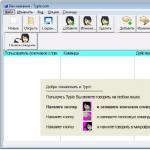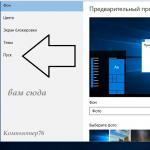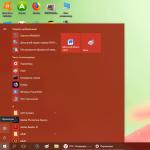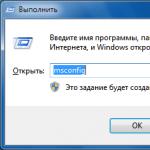The taskbar acts as the main panel in operating system Windows. Displayed here running programs, clock and start button.
By default, this panel is located at the bottom of the desktop. But, due to a software error or user inattention, the Taskbar may move to a different position. For example, to the top of the desktop or to the side face. For most users, this atypical arrangement of the panel is inconvenient. Therefore, they are wondering how to lower the taskbar to the bottom of the desktop.
Move the taskbar to the bottom of the desktop with the mouse
Perhaps the easiest way to bring the taskbar down on the desktop is to use the mouse. In order to use this method, you must first check whether the Taskbar is pinned or not. To do this, click right click mouse on the taskbar and look at the item " Pin the taskbar". If there is a checkmark next to it, then this means that the Taskbar is pinned. To unpin it, click on the menu item "Lock the taskbar" and uncheck it.
After the taskbar is undocked, it can be lowered to the bottom of the desktop using the mouse. To do this, just left-click on an empty space on the Taskbar and, without releasing the mouse button, move the Taskbar to the bottom of the desktop.
After the panel falls to its usual place at the bottom of the screen, it needs to be fixed. To do this, right-click on the mouse and select the "Lock the taskbar" menu item.
Lowering the taskbar using settings
You can also lower the taskbar to the bottom of the desktop using the settings. To do this, right-click on the Taskbar and select "Properties" from the menu that opens.

This will open a window with settings for the taskbar and the Start button. Here on the tab "Taskbar" you can choose the place where the taskbar should be located. In order to lower the Taskbar to the bottom of the desktop, select the “bottom” option and save the settings using the “Ok” button.

Please note that in order to change the location of the Taskbar using the settings, it is not necessary to unlock it.
Solving other problems with the Taskbar
In addition to the above, there are other problems with the Taskbar. We will consider the most common of them below.
- Taskbar disappears and reappears. If your Taskbar appears and disappears, then most likely you have the "Auto-hide the Taskbar" feature turned on. You can disable this feature in the taskbar settings. To do this, right-click on the taskbar, select "Properties" and on the "Taskbar" tab, disable the "Auto-hide the taskbar" function.
- The taskbar is too big. Another problem with the Taskbar is that it is too big. In order to solve this problem, you need to unpin the Taskbar, move the mouse cursor to the edge of the Taskbar and drag it towards the edge of the screen. If you reduce the width of the taskbar with this method if it doesn’t work, then open its properties and activate the “Use small buttons on the taskbar.
By default, the taskbar in the operating Windows system 10 is located at the bottom of the desktop. After turning on the computer, users find that the taskbar is not correctly positioned on the desktop of the computer. This situation can occur on computers that are used by multiple users.
This article will tell you how to move the taskbar to the bottom of the desktop screen of a computer running the Windows 10 operating system. To return the taskbar to its place at the bottom of the desktop, users used to just open the control panel, but now the classic control panel has been replaced by updated Windows 10 system settings.
Desktop
Right-click on the taskbar, and in the context menu that opens, select disable Pin the taskbar. If the parameter is enabled, then the user sees a checkmark next to the item to fix the taskbar, after disabling it will disappear. Next, you will be able to move the taskbar down, up, left or right of the screen with a simple drag and drop.
Options
In updated settings latest version The Windows 10 operating system has the ability to choose the position of the taskbar on the screen without the need to unpin. If we compare with previous versions of the Windows 10 operating system, then this possibility was using the classic control panel.

Please note that when using the updated system settings, there is no need to detach the taskbar from the desktop, but you can immediately select the desired position of the taskbar on the screen.
Registry
All changes configured in the system settings or the classic control panel are made to the registry of the operating system. It is enough for the user to know what value and what registry setting needs to be changed for the desired setting. To make changes to the registry in the Windows 10 operating system, an editor is used. See more or its alternative. We also recommend before making any changes.

To edit the current parameter, you must use the selection of the parameter value being edited. Selecting each item individually, we change the value of the parameter as a whole. The current values are relevant for the latest version of the Windows 10 operating system and allow you to move the taskbar to the bottom of the screen. Please note that after making changes to the registry, you must restart the computer or explorer for them to take effect.
In the age of computer progress, almost every apartment has such a necessary thing as a desktop computer, and many of them have more than a single copy. Every PC owner loves whatever software tool which he uses has been established in a manner convenient to him. But sometimes, with the desktop settings, an unpleasant situation can happen when you boot your computer, you notice that the location of any desktop elements is suddenly not in your usual place, or is completely absent.
Very often this happens with a working panel in programs. windows families, and this article will help you figure out how to return it to its place if it suddenly moved to an unnecessary area or completely disappeared.
The most efficient way
Switch to the desktop, move the mouse arrow over a free space in your taskbar, it should be free from various icons, tabs, and other elements that are in your panel, then right-click the manipulator and in the open list, see if you have the bird opposite the “Lock the panel” column, if there is one, then you need to remove the mark, then hold down the right mouse button on a clean area of \u200b\u200bthe panel, and with a simple movement move it to the bottom sector of the screen. So that in the future the panel does not walk around the desktop, put a bird in front of the "Lock the taskbar" element.
Reanimate using the Panel Properties
You can return the panel to its rightful place thanks to the "properties" menu, the function is located directly in the taskbar itself, in order to find it you need to go to the desktop, direct the arrow to a clean area in your panel, then right-click on the menu and press to the "Properties" element. A menu pops up on your display with various settings taskbar, find in the window an item called “taskbar position”, click on the left button, and select the position from the bottom. It is worth noting that in this column you can also adjust the position to the top, left or right, depending on personal preferences. Don't forget to put a checkmark in the "Lock the taskbar" column to prevent further movement of the location of your panel. In addition, you can customize various other elements of your panel in the "Properties" menu.
Move the panel using the Start menu
You can change the position of the panel through the tools of the Start button, to do this, click on the start icon with the manipulator, find the search bar in the menu, and type the phrase “taskbar” from the keyboard. The computer should display a list with settings. In the drop-down list, select "taskbar settings". The settings menu will pop up on the display. working panel, find the column "location of the taskbar on the display" and select the setting "bottom position".
With the main control
This option requires you to log into the control panel. Click on the start icon, in the drop-down list, select the “control panel” item, you can also use the search bar by typing “control panel” on the keyboard, look for the desired item and press the left mouse button, in the window that appears, find the “view” properties, check the box in the “small icons” item, a large list of settings will open, look for “taskbar settings” in the list that appears, click on it. A menu will open with the taskbar settings functions, select the bottom position submenu and do not forget to put the “pin the taskbar” checkbox.
What to do if the panel suddenly disappeared
There are incidents when, when loading windows, you suddenly cannot find the taskbar on the desktop, all the icons seem to be in place, but the panel is nowhere to be found. Do not rush to panic, most likely, you have the "always hide the taskbar" flag activated. Move the manipulator to the sector of the display where the panel was located. When you hover over the area, the panel should appear. You can also use a special button on the keyboard, the key is located between the Ctrl and Alt commands on the right and left sides of the keyboard, has a proprietary windows sign. When pressed, the panel will appear on the screen, so that it does not disappear again, you need to remove the automatic hiding of the panel, to do this, go to the panel properties and in the submenu that appears, uncheck the "always hide the taskbar" box.
In case of emergency
If suddenly all the methods described do not bring results and the panel does not want to move to the position you need or it is completely absent, then it can help windows loading in security mode (when you boot your computer, select the “Safe Mode” mode), run the antivirus and check the system for infectious programs, system restore can also help, you can find it using the search tool, there is a line in the start panel. Enable System Restore and follow the instructions in the recovery wizard.
Sometimes, when several different users use the computer (for example, employees of the same photo printing company), a situation arises that each user customizes the operating system desktop for themselves. One such setting is the location of the taskbar. Windows allows you to position this panel at the top, bottom, left, or right of the screen area.
Seeing the new location, the new user immediately seeks to change it for themselves. Many are accustomed to the bottom position of this panel, which is the default position. But not many people know how to change it. Therefore, let's take a closer look at how to move the taskbar to the bottom of the screen in several ways.
The considered methods of changing the location of the panel will be demonstrated using the example of working in the Windows 7 operating system. In Windows XP, Windows 10 and other versions of this OS, the principle of action will be exactly the same.
First way
This method is based on the use computer mouse and a functional menu that appears when you click on the taskbar. Assume that the taskbar is at the top of the computer screen area:
Let's describe in steps how to change its location to the bottom in this way:
- Move the mouse cursor over the taskbar and press the right mouse button. When clicked, the following context menu will appear:

- Next, in the menu, click on the item “Lock the taskbar”, if there is a checkmark icon opposite this item. If there is no such checkbox, you do not need to click. By unchecking the box, the panel can be moved:


- At this step, again point the cursor at the panel, press the left mouse button and, without releasing the button, drag the panel to the desired area of the screen: down, left or right. For example, drag the panel down:
Second way
This method is based on the fact that the location of the panel is selected in accordance with the proposed list of positions, which is located in the properties (parameters) of the taskbar. Consider this method step by step:
- Move the mouse cursor over the taskbar and press the right button. In the menu that appears, select the properties item:

- By clicking, a dialog box will open in which you need to go to the "Taskbar" tab, in the "Position of the taskbar on the screen" field, select the desired position from the proposed ones, click the "Apply" and "OK" buttons. In order not to have to worry about whether the panel is pinned, you can immediately check the corresponding checkbox in the “Pin the taskbar” option:

- As a result, the taskbar will move to the selected position on the monitor screen.
Oct 26 2017
Perhaps you are faced with the problem of how to move the taskbar to the bottom of the screen, to the side or to the top. Let's say you or someone else accidentally moved the toolbar to the left, right, or up.
I and many users are used to having the taskbar at the bottom of the screen, but there are those who are used to seeing it in other places. This article will help you move your toolbar to the right place on the desktop.
Return the taskbar to its original place on the screen
Plan for today's review:
- Mouse to help
- Toolbar options
- How to access the taskbar
- Panel setup
I suggest watching a video tutorial on the topic of our article
The mouse is our helper
First of all, I suggest using the mouse and trying to move the toolbar. This method will work if the toolbar is not pinned to the desktop.

We right-click on the free space of the toolbar and look at whether or not there is a checkmark next to pin the taskbar.

If the checkbox is checked, then it can be easily removed, just click on pin the taskbar once with the left mouse button.

Once the checkbox has been removed, find an empty space on the toolbar, press and hold the left mouse button, moving the toolbar to the desired location on your screen.


This is how you move the panel.
Change taskbar settings
Go to the toolbar, right click on free space panel and open the taskbar settings with the gear.

We find the option for the location of the toolbar on your screen and select the one you need from four items: left, right, bottom or top.

How to get to the toolbar
The second way to open the panel. Right-click on an empty space on the desktop. In the pop-up context menu, go to personalization.

In personalization, open the bottom left tab of the taskbar.

start menu
The third way to open it is through the start menu. Go to start menu -> settings.

AT Windows settings we find the second tab - personalization: background, lock screen, colors.

Go to the panel and configure.
The start menu can be used in other ways as well. Right click on the start menu -> options -> personalization -> toolbar.

Control Panel
Open the control panel icon - change settings and settings functionality this computer.

Let's move on to design and personalization - change appearance desktop elements, apply themes, screen savers, taskbar.

We tear off the toolbar and navigation, or navigation properties - customize the panel, change the list of displayed elements and appearance.

Windows search
The fifth way, we use the search in Windows. Click on the magnifying glass next to the start menu and type the text - the taskbar.

Go to the toolbar options.
Run window
The sixth way, launch the taskbar through the run window.
Open it by pressing two buttons on the keyboard, "Win + R".

Enter the command without quotes: "control / name Microsoft.TaskbarAndStartMenu" and click OK.

We make our settings.
Customizing the toolbar
The panel can be customized to your needs, here are extensive settings:
- Pinning the taskbar
- Auto-hide panel in desktop mode
- Automatically hide panel in tablet mode
- Use small buttons on the panel
- Show desktop when hovering over Minimize All Windows
- Display badges on panel buttons
- Location
- Grouping buttons
- notification area
- Multiple displays
- Show contacts of people

If you work as a designer, architect and the panel interferes with your work, you can remove it, move the slider to hide the panel.

You can also reduce the taskbar icons, drag the slider to enable the small toolbar buttons.
Results
Today we have learned how to move the taskbar to the bottom of the screen and any place on the desktop. Learned six ways to open the toolbar and customized it for yourself.
You may have questions related to how to move the taskbar to the bottom of the screen. You can ask about it below in the comments to this article or use the form with me.
Also, you can ask any questions related to computer topics On the page .
Thank you for following me on Twitter.
Stay connected - my You Tube channel.
If the above information turned out to be useful to you, then I recommend subscribing to my blog updates to always be aware of fresh and relevant information on setting up your computer.




